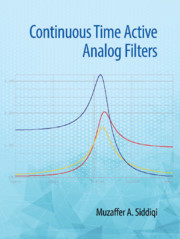Book contents
- Frontmatter
- Dedication
- Contents
- Preface
- Acknowledgments
- 1 Analog Filter: Concepts
- 2 First-and Second-order Filters
- 3 Magnitude Approximations
- 4 Delay: Approximation and Optimization
- 5 Frequency and Impedance Transformations
- 6 Sensitivity of Active Networks
- 7 Single Amplifier Second-order Filters
- 8 Multi Amplifier Second-order Filter Sections
- 9 Direct Form Synthesis: Element Substitution and Operational Simulation
- 10 Cascade Approach: Optimization and Tuning
- 11 Amplification and Filtering in Biomedical Applications
- 12 Audio Signal Processing and Anti-aliasing Filters
- 13 Follow the Leader Feedback Filters
- 14 Switched Capacitor Circuits
- 15 Operational Transconductance Amplifier-C Filters
- 16 Current Conveyors and CDTA (Current Differencing Transconductance Amplifiers) Based Filters
- 17 Active R and Active C Filters
- Index
- References
12 - Audio Signal Processing and Anti-aliasing Filters
Published online by Cambridge University Press: 24 December 2019
- Frontmatter
- Dedication
- Contents
- Preface
- Acknowledgments
- 1 Analog Filter: Concepts
- 2 First-and Second-order Filters
- 3 Magnitude Approximations
- 4 Delay: Approximation and Optimization
- 5 Frequency and Impedance Transformations
- 6 Sensitivity of Active Networks
- 7 Single Amplifier Second-order Filters
- 8 Multi Amplifier Second-order Filter Sections
- 9 Direct Form Synthesis: Element Substitution and Operational Simulation
- 10 Cascade Approach: Optimization and Tuning
- 11 Amplification and Filtering in Biomedical Applications
- 12 Audio Signal Processing and Anti-aliasing Filters
- 13 Follow the Leader Feedback Filters
- 14 Switched Capacitor Circuits
- 15 Operational Transconductance Amplifier-C Filters
- 16 Current Conveyors and CDTA (Current Differencing Transconductance Amplifiers) Based Filters
- 17 Active R and Active C Filters
- Index
- References
Summary
Introduction
Two important areas of analog filter applications are included in this chapter: audio signal processing (ASP) and study of anti-aliasing/reconstruction (AA/ReF) filters.
In ASP, the frequency range of operation is from a few Hz to around 20 kHz. All the different types of filters, that is, LP (low pass), BP (band pass), HP (high pass), BE (band elimination) and AP (all pass) filters, can be used. Hence, in most applications, general purpose OAs (operational amplifiers) may be used while taking care of noise signals. Generally, order of the filters may not be very high; whereas, in AA/ReF, only LPFs are used for which the frequency range of operation depends on specific applications. Hence, the selection of OA is to be considered carefully. Order of the filter can also be high.
One of the major objectives in ASP is to improve audio signals employing different approaches. Section 12.2 discusses this aspect in terms of crossover networks and filters eliminating infrasonic and ultrasonic undesired signals. Section 12.3 discusses a specific case which addresses the unequal power output requirements of the satellite speaker and the subwoofer speaker system. Equalization using mid treble boost/cut and mid bass boost/cut, which are part of programmable equalizers are studied in Section 12.4. Section 12.5 takes up certain aspects of the Record Industry Association of America (RIAA) in brief. An application of phase approximated filters in ASP is explained in Section 12.6.
The essential nature of AA/ReF filters is described in Section 12.7 citing the example of a filter design for a 12-bit ADC. A detailed case is presented in Sections 12.8 and 12.9 showing the application of high frequency AA and ReF filters used in video signal processing.
Improvement in Audio Performance
Problems in the frequency response of audio systems and loudspeakers are resolved using active analog audio filters. Of course, the ways these filters are used depend on the required end result. For example, in some cases, filters are required to produce a response which is nearly the inverse of the response of the (say) loudspeaker or any other audio speaker. Hence, when the two responses are combined, it results in a nearly flat response.
Information
- Type
- Chapter
- Information
- Continuous Time Active Analog Filters , pp. 360 - 397Publisher: Cambridge University PressPrint publication year: 2020
